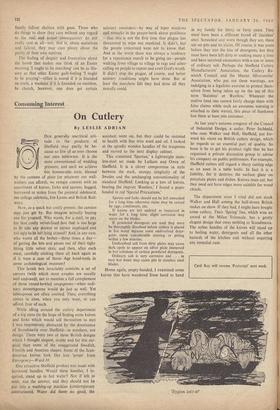Consuming Interest
On Cutlery
By LESLIE ADRIAN OUR generally uncritical atti- tude to the products of Sheffield may partly be be- cause so few of us ever choose our own tableware. It is the most conventional of wedding presents; and until we achieve this honourable state, blessed by the canteen of plate (or whatever our well- wishers can afford), we remain content with an assortment of knives, forks and spoons, begged, borrowed or stolen from the parental sideboard, the college cafeteria, Joe Lyons and British Rail- ways.
Now, as a quick but costly present, the canteen may just get by. But imagine actually buying one for yourself. Who wants, for a start, to pay for that costly velvet-lined box that is too large to fit into any drawer or corner cupboard and too ugly to be left lying around? And, in any case, who wants all the bother—three times a day— of getting the bits and pieces out of their tight- fitting little velvet slots, and then, after each meal, carefully sticking them all back again as if it were a case of Stone Age hand-tools in some archeological museum?
This lavish box invariably -contains a set of carvers (with which most couples are usually well endowed), not to mention a full complement of those round-bowled soupspoons—when ordi- nary dessertspoons would do just as well. Yet tablespoons are often omitted. Then, everything comes in sixes, when you only want, or can afford, four of each.
While idling around the cutlery department of a big store (in the hope of finding some knives and forks which would sell themselves to me) I was impressively dismayed by the dominance of Scandinavia over Sheffield—in numbers, not design. There were two or three British designs which I thought elegant, usable and far less sur- gical than some of the exaggerated Swedish, Finnish and Austrian shapes. Some of the Scan- dinavian knives look like lost 'props' frcom 'Emergency—Ward 10.
One attractive Sheffield product was made with boxwood handles. Would these handles, I in- quired, stand up to hot water? Not if left to soak, was the answer, and they should not be put into a washing-up machine (contemporary contrariness). Water did them no good, the assistant went on, but they could be restored to health with fine wire wool and oil. I looked at the spindly wooden handles of the teaspoons and moved to the next display cabinet.
This contained 'Spartan,' a lightweight stain- less-steel set made by Latham and Owen of Sheffield. It is a clever compromise in style between the stark, stumpy simplicity of the Swedes and the unchanging conventionality of standard Sheffield. Looking at a box of knives, bearing the imprint `Rustless,' I found a paper headed in red 'Special Precautions.'
Spoons and forks should not be left unwashed for a long time otherwise stains may be caused by eggs, condiments, etc.
If knives are left undried or immersed in water for a long time, slight corrosion may occur on the blades.
If powdered detergents are used they must be thoroughly dissolved before cutlery is placed in hot water because some undissolved deter- gents cause considerable staining or pitting within a few minutes.
Undissolved salt from dirty plates may cause dark. spots to appear on silver plate immersed in hot solutions of certain powdered detergents.
Ordinary salt is very corrosive and . . . in very hot water may cause pits in stainless steel blades.
Home again, empty-handed, I examined some knives that have wandered from hand to hand
'Stygian, isn't it?'
in my family for thirty or forty years. They must' have been a different brand of 'stainless' steel. Scratched and worn though they are, there are no pits and no stains. Of course, it was years before they met the bite of detergents, but they must have been left dirty or soaking many a time and have survived encounters with a ton or more of ordinary salt. Perhaps the Sheffield Cutlery Manufacturers' Association, the Cutlery Re- search Council and the Master Silversmiths' Association, who put out these warnings, are indulging in a legalistic exercise to protect them- selves from being taken up on the use of this term 'Stainless' or `Rustless.' Whatever the motive (and one cannot fairly charge them with false claims while such an awesome warning is attached to their wares), this piece of frankness lost them at least one customer., At last year's autumn congress of the Council of Industrial Design, a cutler, Peter Inchbald, who runs Walker and Hall, Sheffield, put for- ward his views on British cutlery design, which he regards as an essential part of quality. So keen is he to get his product right that he has organised a private discussion group to advise his company on public preferences. For example, Sheffield cutlers still regard a sharp cutting edge as an asset in a table knife. In fact it is a liability, for it destroys the surface glaze on porcelain plates and dishes. Knives must cut, but they need not have edges more suitable for wood chisels.
The department store I tried did not stock Walker and Hall among the half-dozen British makes on show. If they had, I might have bought some cutlery. Their 'Spring' line, which won an award at the Milan Triennale, has a gently elegant design that owes nothing to Scandinavia. The nylon handles of the knives will stand up to boiling water, detergents and all the other hazards of the kitchen sink without requiring any remedial care.






































 Previous page
Previous page